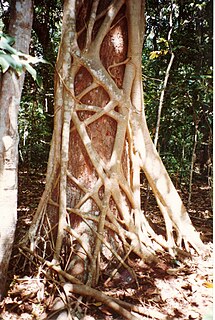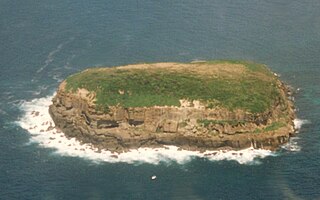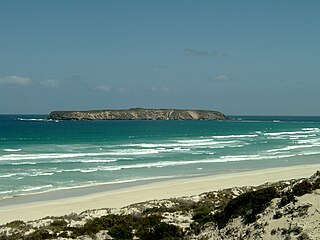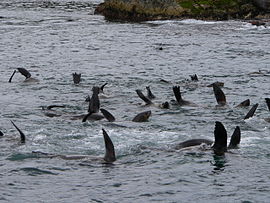
Lion Island is a river island that is located at the mouth to the Hawkesbury River inside Broken Bay, in the state of New South Wales, Australia. The island is considered part of the Central Coast Council. It is a descriptive name because it resembles a Sphinx, a mythical figure of a crouching lion.

Guafo Island is an island located southwest of Chiloé Island and northwest of Chonos Archipelago, Chile. This location and the prevailing westerly winds bring frequent rainstorms to the island. Ocean currents bring an abundance of fish into this area, making it one of the most productive marine areas in the Southern Pacific Ocean. Because of this, numerous marine vertebrates such as fur seals, sea lions and penguins come to the island to feed and reproduce.

The Five Islands Nature Reserve is a protected nature reserve located in the Tasman Sea, off the Illawarra east coast of the state of New South Wales, Australia. The 26-hectare (64-acre) reserve comprises five continental islands that are situated between 0.5 and 3.5 kilometres east of Port Kembla. The Five Islands are Flinders Islet, Bass Islet, Martin Islet, Big Island and Rocky Islet.

The Wilsons Peak Flora Reserve is a protected nature reserve that is located in the Northern Rivers region in the state of New South Wales, in eastern Australia. The reserve is bounded to the north by the border between New South Wales and the state of Queensland. The nearest town is the Queensland settlement of Killarney.

The Davis Scrub Nature Reserve is a protected nature reserve that is located in the Northern Rivers region of New South Wales, Australia. The 13-hectare (32-acre) reserve is a sub tropical rainforest remnant of the Big Scrub and is situated at 170 metres (560 ft) above sea level on an undulating high rainfall plain near Alstonville.

The Susan Island Nature Reserve is a protected nature reserve containing Susan Island, a river island, that is located in the Clarence River, in the Northern Rivers region of New South Wales in eastern Australia. The 23-hectare (57-acre) reserve is situated near Grafton. The island and reserve is a rare 16.5-hectare (41-acre) example of sub tropical lowland rainforest.

The Andrew Johnston Big Scrub Nature Reserve is a protected nature reserve in the Northern Rivers region of New South Wales, Australia. A subtropical jungle remnant of the Big Scrub, the 21-hectare (52-acre) reserve is approximately 19 kilometres (12 mi) northeast of Lismore. Far less than 1% of the original Big Scrub now remains.

The Iluka Nature Reserve in a protected nature reserve that is located in the Northern Rivers region of New South Wales, Australia. The 135-hectare (330-acre) reserve is situated near the coastal town of Iluka.

The Montague Island Light is a heritage-listed active lighthouse located on Montague Island, an island in the Tasman Sea, 9 kilometres (5.6 mi) offshore from Narooma on the south coast of New South Wales, Australia. The lighthouse is located at the highest point of the island. It was designed by James Barnet and NSW Colonial Architect and built from 1878 to 1881 by J. Musson and completed By W. H. Jennings. It is also known as the Montague Island Lightstation and its setting. The property is owned by the Office of Environment and Heritage, an agency of the Government of New South Wales. It was added to the New South Wales State Heritage Register on 2 April 1999, and the Commonwealth Heritage List on 22 June 2004.

The Yathong Nature Reserve is a protected nature reserve that is also a nationally and internationally recognized biosphere situated in the central-western region of New South Wales, in eastern Australia. The 107,240-hectare (265,000-acre) reserve was listed by UNESCO in 1977 as a Biosphere Reserve under the Man and the Biosphere Programme (MAB). The reserve is significant for its biodiversity in both native plant and animal species. Cultural heritage and historical grazing activities add to the significance of this site as a conservation area.

The Brush Island is a continental island, contained within the Brush Island Nature Reserve, a protected nature reserve, known as Mit Island in the Dhurga language of the Murramamrang people of the Yuin nation see It is located off the south coast of New South Wales, Australia. The 47-hectare (120-acre) island and reserve is situated within the Tasman Sea, approximately 2 kilometres (1.2 mi) south-east of the coastal village of Bawley Point.

.

The Hayters Hill Nature Reserve is a protected nature reserve that is located in the Northern Rivers region in the state of New South Wales, in eastern Australia. The 8-hectare (20-acre) forest remnant is located on high ground some 5 kilometres (3.1 mi) southwest of Byron Bay.

The Bird Island Nature Reserve is a protected nature reserve located near Lake Munmorah on the Central Coast region of New South Wales, Australia. The island is situated 1.4 kilometres (0.87 mi) off the east coast of New South Wales, within the Tasman Sea. The reserve may be seen from the lighthouse at Norah Head.

Batemans Bay is an open oceanic embayment that is located in the South Coast region of New South Wales, Australia. The bay forms the mouth of the Clyde River and its primary outflow is to the Tasman Sea of the South Pacific Ocean.

The Whidbey Isles Conservation Park is a protected area in the Australian state of South Australia which consists of seven islands located about 15 kilometres (9.3 mi) west-southwest of Coffin Bay on the lower Eyre Peninsula.

Solitary Islands Marine Park (SIMP) is a marine park in New South Wales State waters, Australia. It adjoins the Solitary Islands Marine Reserve and was declared under the Marine Parks Act 1997 (NSW) in January 1998. Prior to this it was declared a marine reserve in 1991. The Park was one of the first declared in NSW and stretches along the northern NSW coast, from Muttonbird Island, Coffs Harbour, to Plover Island near Sandon River, 75 kilometres to the north. It includes coastal estuaries and lakes and extends from the mean high water mark, to three nautical miles out to sea, covering an area of around 72 000 hectares. There are five main islands in the Park, North Solitary Island, North West Solitary Island, South West Solitary Island, South Solitary Island and Split Solitary Island, as well as other significant outcrops such as Muttonbird Island and submerged reefs.
Muttonbird Island Nature Reserve is a nature reserve off the shore of Coffs Harbour, New South Wales, Australia, on the southern boundary of the Solitary Islands Marine Park. It is linked to the mainland by a causeway, which acts as the northern breakwater for the harbour. With over 5,500 breeding pairs, it is a major breeding ground for wedge-tailed shearwaters, known locally as muttonbirds, which migrate annually to the Philippines but return to breed on the island.

.

Cook Island Nature Reserve is a protected area in the Australian state of new South Wales located on Cook Island about 600 metres (2,000 ft) off the coastline from the headland of Fingal Head and about 4 kilometres (2.5 mi) south-east of Tweed Heads on the state's north coast.





















